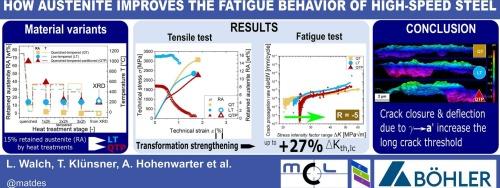奥氏体如何改善高速钢的疲劳性能
IF 7.9
2区 材料科学
Q1 MATERIALS SCIENCE, MULTIDISCIPLINARY
引用次数: 0
摘要
优化刀具材料(如高速钢)的疲劳性能对于提高零件和金属加工工具的使用寿命至关重要。这方面的一个重要特性是材料对短裂纹扩展的阻力,这在循环r曲线行为中很明显。对一种保留大量亚稳奥氏体的高速钢牌号进行了相变诱导裂纹闭合提高其抗疲劳裂纹扩展能力的研究。评价了循环热载荷下奥氏体对马氏体转变的抵抗能力。采用同步辐射x射线原位测定奥氏体含量的拉伸试验研究了变形诱发塑性。当应力比R = 0.1、- 1和- 5时,循环R曲线行为和疲劳裂纹扩展阈值被确定。疲劳行为的关键参数,如循环r曲线的斜率和应力强度因子范围内的长裂纹阈值,相对于可比的行业相关材料状态有显著改善。本文章由计算机程序翻译,如有差异,请以英文原文为准。

How austenite improves the fatigue behavior of high-speed steels
Optimizing the fatigue performance of tool materials, such as high-speed steels, is crucial for increasing the service life of parts and metalworking tools. An important property in this respect is a material’s resistance to the propagation of short cracks, evident in cyclic R-curve behavior. The potential to improve the fatigue crack propagation resistance by transformation-induced crack closure was studied for a high-speed steel grade in which significant fractions of metastable austenite were retained. The austenite’s resistance to martensitic transformation under cyclic thermal loads was evaluated. Transformation-induced plasticity was studied using tensile tests with in situ determination of austenite content by X-ray diffraction using synchrotron radiation. The cyclic R–curve behavior and the threshold for fatigue crack propagation were determined for stress ratios of R = 0.1, −1, and −5. Critical parameters regarding fatigue behavior, such as the slope of the cyclic R-curve and the long crack threshold of the stress intensity factor range, were significantly improved relative to comparable industry-relevant material states.
求助全文
通过发布文献求助,成功后即可免费获取论文全文。
去求助
来源期刊

Materials & Design
Engineering-Mechanical Engineering
CiteScore
14.30
自引率
7.10%
发文量
1028
审稿时长
85 days
期刊介绍:
Materials and Design is a multi-disciplinary journal that publishes original research reports, review articles, and express communications. The journal focuses on studying the structure and properties of inorganic and organic materials, advancements in synthesis, processing, characterization, and testing, the design of materials and engineering systems, and their applications in technology. It aims to bring together various aspects of materials science, engineering, physics, and chemistry.
The journal explores themes ranging from materials to design and aims to reveal the connections between natural and artificial materials, as well as experiment and modeling. Manuscripts submitted to Materials and Design should contain elements of discovery and surprise, as they often contribute new insights into the architecture and function of matter.
 求助内容:
求助内容: 应助结果提醒方式:
应助结果提醒方式:


